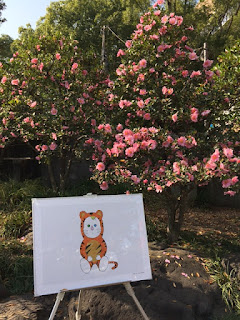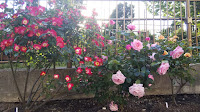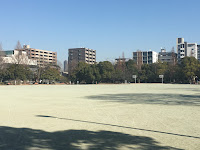We visited a Tategu joiner’s workshop located at a five-minute walk from Kiyosumi-Shirakawa Station in Koto city.
 |
| The signboard of the workshop |
What is Tategu? Tategu is architectural fittings such as sliding doors and partition screens, which is an essential
part of traditional Japanese wooden houses. It requires a lot of fine work and
connections of wooden parts are made mortise and tenons without using nails.
 |
| Mr. Tomokuni talking about a screen with Kumiko patterns |
Mr. Tomokuni, the Tategu joiner we met there, is designated as a prominent craftsman (great craftsman in the present world) by the Japanese government. One of his important works is sliding doors at the
Pine Teahouse (Matsu no Ochaya)” in Hamarikyu Gardens, a national special
scenic spot and a special historic site.
At the workshop, Mr. Tomokuni talked about Tategu including its materials, tools, techniques etc. His talk was very
interesting and fun. We felt his pride as a craftsman and his warm personality
at the same time from his talk. He said that Tategu joiners’ names are
not written on most of their works, but excellent techniques are used invisibly
and should be kept even under the situation of decreasing demands for
traditional wooden fittings.
 |
| Various planes |
 |
| Mr.Tomokuni instructs a member of KEV trying to plane a board |
 |
| The craftsman’s hands |
We experienced to make a Kumiko coaster by fabricating
fine and thin pieces of wood already prepared by Mr.
Tomokuni. Kumiko is a technique of fine woodworking to decorate sliding
doors or screens. The geometric pattern formed on the coaster is called “Masu
tsunagi”, or “linked square measuring boxes”, which
means a pray for prosperity. According to Mr. Tomokuni, there are more than 200
traditional patterns with auspicious meanings for Kumiko and many of
them came from patterns used on Japanese clothes.
| A beautiful example of Kumiko woodworking |
 |
 |
| fine wooden pieces for the coaster | the coaster with “linked square measuring boxes” pattern |
 |
| Some examples of Kumiko patterns |
We learned a lot about Tategu from this visit
and took the coaster home carefully.
Are you interested in the world of fine woodworks? KEV
is happy to arrange a tour to the workshop including an experience of making a Kumiko
coaster.
By Nobuko



































